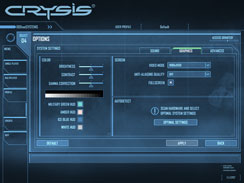First Look: Nvidia 3-way SLI on nForce 680i
December 13, 2007 | 14:01

Crysis
Publisher: Electronic ArtsWhat can we say about this game that hasn’t been said already? Crysis is probably the most anticipated game on the PC this year and was released on November 16th.
Crysis is seen by many as the poster boy for DirectX 10 and it will make your system cry, quite literally – it’s a monster! It doesn’t come as much of a surprise then, that the graphics are something special – they’re above and beyond anything we’ve ever seen in a PC game.
We tested the game under both DirectX 9.0 and DirectX 10 using a custom timedemo and is more representative of gameplay than the built-in benchmark, which renders things much faster than you’re going to experience in game. We found that around 30-35 fps in our timedemo was sufficient enough to obtain a playable frame rate through the game. It’s a little different to other games in that the low frame rates still appear to be quite smooth.
For our testing under DirectX 9.0, we set all of the in-game settings to high, while for DirectX 10 testing, we set all details to very high. Because of how intense the game is, we tested with anisotropic filtering disabled for the time being, but we controlled anti-aliasing from inside the game. There is currently no support for anisotropic filtering in the game, but you can still force it from the driver control panel.
DirectX 9.0
Let’s tackle Crysis in two chunks, because there were some things we saw when we ran the game under DirectX 9.0, but weren’t there when we played the game in DirectX 10 mode with all of the settings tuned to ‘Very High’.
First and foremost, scaling starts off pretty well at 1600x1200 with 4xAA applied and you actually get better scaling with three GPUs than you do with just two. Things changed when we moved to 1920x1200 0xAA though, as there was no longer enough load (which sounds like a strange thing to say about Crysis) to show any true benefits from adding the third card.
Then, at 1920x1200 with 4xAA applied, we saw some rather strange things with two GeForce 8800 Ultra graphics cards in SLI mode, as it turned out to be slower than a single GeForce 8800 Ultra. We passed this back to Nvidia, but we are yet to receive a fix—or even a real explanation as to what’s going on (or if it’s something that the performance labs haven’t been able to replicate... we’ve certainly had a situation like that in the past).
With that said though, we managed to see decent scaling to three GeForce 8800 Ultras, more than doubling the performance of a single Ultra and delivering playable frame rates at the maximum settings available in the game’s control panel under DirectX 9.0. There are, of course, ways to enable some of the ‘Very High’ settings under DX9, but that involves messing around with configuration files and it’s not officially supported by Crytek (or either GPU manufacturer for that matter).
Update:
Nvidia tells us that the issue might be related to the driver we've used here - I'm just running some tests on the driver that's on Nvidia's website.
DirectX 10
DirectX 10 is where things start to get interesting though, as Nvidia says that the promise is to deliver playable frame rates at 1920x1200 with all settings turned up to ‘Very High’. This just about happened, although we found that turning post processing down to ‘High’ really did give us pretty playable frame rates.
All of a sudden, our frame rates jumped from mid-to-high 20s, dropping into single figures when we looked around rather quickly, to over 30 frames per second on average and staying well above 10 frames per second when we moved around. The reason for this is that the motion blur effect wasn’t quite so pronounced and, as I’m sure you know, many have found that the motion blur effect is pretty harsh at times and can cause you to feel a bit of nausea.
Anyway, scaling looked to be pretty good across the board in our custom demo and 3-way SLI with three GeForce 8800 Ultras actually turns fairly unplayable frame rates into frame rates that verge on playability. This isn’t a bad start when you consider that there are promises for more multi-GPU performance from the soon-to-be-released patch – we’ll be coming back to test this when it’s released.

MSI MPG Velox 100R Chassis Review
October 14 2021 | 15:04










Want to comment? Please log in.